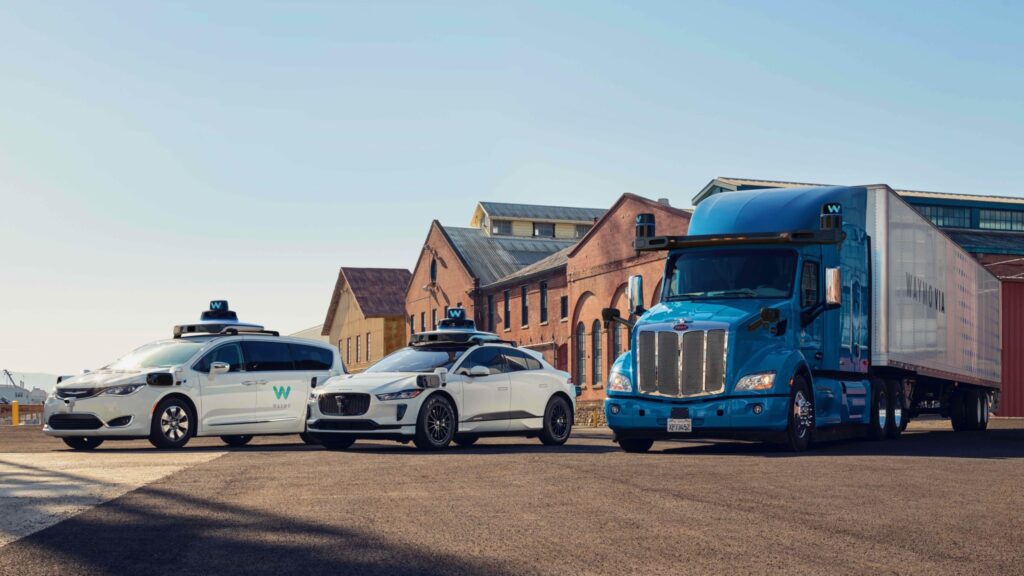Waymo Answers: An interview with Waymo’s Matt Carroll
The Canada Pension Plan Investment Board is now a major investor in Waymo – an autonomous vehicle initiative that was born as Google’s self-driving car project. But the Canadian content doesn’t end there. Matt Carroll, product manager for trucking, is a native of London, Ont.
Today’s Trucking caught up with Carroll to discuss advances at Waymo, and advances in the journey toward higher levels of autonomous trucks.

TODAY’S TRUCKING: Can you describe what some of Waymo Via’s recent tests have involved? Most important, what insights did they offer?
MATT CARROLL: We started working on Class 8 trucks back in 2017, seeing how we could adapt our technology to this platform and address some of the challenges that exist within the trucking industry, from driver shortages to efficiency gaps.
In 2018, we launched the first pilot with our self-driving trucks to help deliver freight to and from Google’s Data Centers in Atlanta, Ga. Atlanta is one of the biggest logistics hubs in the country, which made it a perfect environment for an early test for our self-driving trucks.
Though the pilot was completed in 2018, we did hundreds of runs in Atlanta, which helped us understand what shippers want in a self-driving solution and how to integrate such a solution into the operations of shippers and carriers, with their network of factories, distribution centers, ports, and terminals. Some specific learnings included what happens if our Waymo Driver takes different routes than a human driver does, or how do we handle the logistics on either end that drivers normally take care of.
In 2020, we’re focusing our testing in Arizona, New Mexico, and Texas.
These are not one-off tests. Rather, they are an ongoing, daily effort to measure our systems performance and capture data in unique scenarios. The Waymo Driver learns from these events so that it’s prepared to handle similar situations when there is no test driver in the vehicle.
We’re currently driving with test loads, which enables us to focus on routes where we are most likely to discover difficult driving situations rather than only driving in a shipper’s lane.
It’s hard to distill what we learn into a few key insights. When developing a self-driving vehicle, it’s important to encounter and learn from the long tail of rare situations that happen on the road, test against them in simulation and on closed courses, then measure the Waymo Driver’s performance until we are ready to remove the human test driver from the cab. Every day, the Waymo Driver gets a little bit better than the day before.

TODAY’S TRUCKING: Waymo tests are gaining insights into light-duty applications (Waymo One) and trucks (Waymo Via) alike. It’s a unique perspective. Can you offer examples of learnings that have applied to both vehicle classes? Can you describe some of the specific challenges that are unique to Class 8 vehicles?
MATT CARROLL: The way we think about it is that we’re building the “driver” — the Waymo Driver — which can be applied across a number of different vehicle platforms ranging from minivans to Class 8s. These vehicles can then power various use cases from ride-hailing under Waymo One, to local delivery and trucking under Waymo Via.
We’ve been heavily focused on passenger car platforms since we started in 2009, but as we continue to ramp up Waymo Via, we’ve been focused on adapting our driver to this platform and seeing where we have a lot of value transfer between cars and trucks, and also what we need to fine tune specifically for trucks. So, we’re in this unique position where we benefit from the same advances across both vehicle classes.
Perhaps unsurprisingly, most lessons we learn benefit the Waymo Driver on all platforms. A lot of the things we learned about driving our cars helps us drive our trucks and, conversely, driving a truck gives us a new perspective that will help us be a better driver in our passenger cars, too.
There are some new considerations specific to trucking that we do have to account for along the way, some of which may be obvious and some which might not be. Domain – Trucks spend more of their time on highways which involve higher speeds. Slower acceleration and braking. Higher mass of the vehicle. Trailer with varying amounts of loads. Maneuvering with wider turns. Larger blind spots.
So, we adjust our hardware and software to take into account these differences. Some key examples would be with our hardware (our trucks use the same types of custom-built sensors, but we place them differently around the truck), our software (the core algorithms based on which the Waymo Driver perceives objects around it or decides when and how to lane change are similar, but are tuned for trucks and their specific domain), and infrastructure (all of our simulation infrastructure is directly applicable to both vehicles, though we are able to add some distinct features for trucks such as tweaking how other road users would respond to our vehicle’s actions if it’s a self-driving truck instead of a self-driving car).
TODAY’S TRUCKING: In the context of commercialization, do you believe that autonomous trucks would be deployed before or after autonomous cars? Why is that? Would the timelines be significantly different?
MATT CARROLL: We’re deploying the Waymo Driver across both of these platforms and products in parallel, and we’re aggressively ramping up our investment in the trucking application. It’s certainly hard to predict, and both opportunities are massive, but there is a possibility that enterprise customers may adopt our technology faster than ride-hailing consumers since the business case is so strong in the commercial sector.
That said, there are so many interdependent market factors that make it difficult to determine at this stage in our various deployments.
For further context, we’re currently operating a fully driverless service with our passenger cars in the Phoenix area, where thousands of riders using our app have the ability to hail a completely empty vehicle within a 50-square-mile territory.
On
the truck side, we are not yet operating fully driverless, but our experience
on the car side will help us accelerate the path to that. We will likely see
fully driverless trucks across the industry begin to hit the road within the
coming years. Though it won’t be a flip the switch moment, as we’ll
remove the drivers gradually, just like we did on the passenger car side.
TODAY’S TRUCKING We’ve tracked advances in everything from LiDAR to v2i
platforms. In recent years, what have been some of the most important technical
gains when it comes to realizing the vision of a Level 4/5 autonomous truck?
Can you describe some of the remaining technical barriers to be overcome? Where
do you expect the solutions to be found?
MATT CARROLL: One of the key hurdles in self-driving is ensuring that robust redundancies are in place. Right now, there are no off-the-shelf trucks with all of the redundant safety features important for full self-driving, such as redundant braking and steering. On the passenger car side, we’ve had access to multiple generations of vehicles with redundancy. But on the truck side, the industry isn’t as far down this path yet. To tackle this challenge, we’re using our learnings and methodical approaches from the passenger car side to work with OEMs and Tier 1s to quickly develop L4-capable trucks.
Another challenge is driving on non-freeway streets, which we call surface streets. Surface streets are a much more challenging domain compared to freeways since they tend to be more unstructured. The differences between one and another tend to vary more, while highways are pretty similar to one another, and there are more long-tail events to consider and test against.
This
year, in our trucking program, we’re mainly focusing on freeway testing — routes
longer than 100 miles. The conditions on these routes are ideal to start this
deployment since long stretches of highway miles tend to be the most tiring for
humans to drive. When we switch our focus to surface streets, we’ll have a
built-in advantage from our experience with surface streets from our Waymo One
and local delivery operations with passenger cars.
TODAY’S TRUCKING: Have you partnered with any third-party fleets
and/or shippers in your truck-specific tests?
MATT
CARROLL: We’re always in conversations with others in the
industry to ensure we’re designing a product that will meet their needs and
fill the gaps that exist today within trucking and their own specific fleets.
We’ve already carried loads for Google’s logistics division in a pilot in
Atlanta, and we’re very interested in doing both external trial runs and pilots
with partners in the future.
TODAY’S TRUCKING: We are already seeing commercial applications of
autonomous vehicles in highly controlled areas such as mines. But what on-road
applications are expected to be the earliest adopters?
In terms of specific use cases, there are segments within the industry that will be automated sooner than others. Waymo Via trucking plans to first tackle line- and long-haul routes and focus on routes where the majority of the miles are on highways.
Highways are much more structured driving environments than city streets, from a technical complexity standpoint.
We will also handle driving on a limited amount of surface streets to depots, whether that’s an LTL terminal, or warehouse, or distribution center.
Moreover, the line- and long-haul markets are quite large compared to other segments.
All of the above reasons make it a great setting for the first deployment of our technology and our conversations with fleets confirm that they see a lot of value in this.
Have your say
This is a moderated forum. Comments will no longer be published unless they are accompanied by a first and last name and a verifiable email address. (Today's Trucking will not publish or share the email address.) Profane language and content deemed to be libelous, racist, or threatening in nature will not be published under any circumstances.
Autonomous trucks are a subject that I get asked about a lot, by those not in the industry. All of the testing in the south, where weather presents fewer challenges, will give good information. Since Matt is Canadian, I was hoping for Canada (and Northern US) weather related questions, specifically relating to snow and slush or salt grime build up on the sensors, etc. I guess they have to focus on getting systems to work well in good conditions before bombarding it with other issues.
Whenever I see anything about autonomous trucks, I wonder about liability and who will secure the loads. In the event of a collision, who do the lawyers go after?
The trucking company, even though it isn’t their programming that is causing the truck to do what it does. Or the manufacturer, since it their logarithms that guide the trucks through their actions. Anybody that has experience with major litigation relating to an incident knows that everybody involved can be a target of lawyers seeking huge settlements. Will the focus change from the trucking company to the manufacturers as this progresses?
Load security is another issue, since, especially in the open deck segment, most shippers don’t currently want the liability of having a driver on their dock or site, working to tie down or tarp a load. So if there is no driver present, who ensures the requirements of NSC Standard 10, relating to cargo securement are met?
Just a few thoughts relating to the topic.